| Back to Back Issues Page |
 |
|
Bangkok Travelbug September 10 The battle of Ao Manao 1941 August 30, 2010 |
| Hello
Prachaup Khiri Khan Prachuap Khiri Khan, a province established in 1845, is about 280 km south of Bangkok. As the last province in Central Thailand, it’s the gateway to the south. Just south of Prachuap is Chumphon, the first province in southern Thailand. The popular beach resort of Hua Hin is in Prachuap Khiri Khan province or Prachuap for short. The provincial capital of the same name is a fishing port about 80 km south of Hua Hin. Prachuap town is located in a beautiful bay, Ao Prachuap or Prachuap Bay. 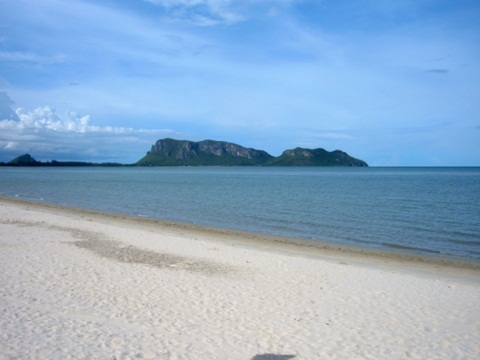
Ao Prachuap – Prachuap Bay Just 5 km south of Prachuap town is Ao Manao, the Bay of Lemons, so-called because of its shape. These bays, besides having pristine beaches, are sheltered from the rough seas during the north-east monsoon at year’s end. 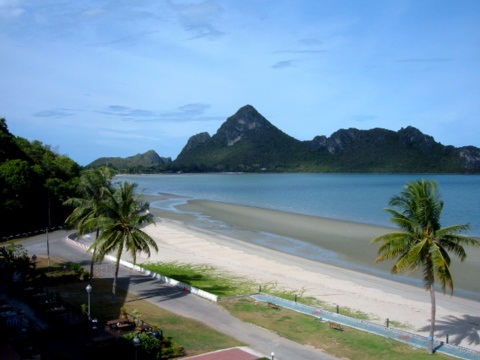
Ao Manao – the Bay of Lemons A narrow strip of land separates the two bays. At the tip of this headland stands a steep rocky mountain, Khao Lom Muak which overlooks the waters of both bays. View Ao Manao in a larger map At the base of this headland is the airfield of 5 Air Wing, Royal Thai Air Force, the target in the battle to come. Table of contents World War II in Thailand Bangkok – 7 December 1941, late in the evening The Japanese ambassador to Thailand made a formal request for the passage of Japanese troops through Thailand for the invasion of Burma and Malaya. As the Prime Minister Field Marshall Plaek Phibunsongkhram wasn’t in Bangkok, the Thai Foreign Minister Direk Jayanama denied the request. But this wasn’t going to stop the Japanese. Their naval task forces and troop carriers were already en route to strike Pearl Harbour and invade Hong Kong, Philippines, Burma, Malaya, Midway and Guam. On a common time zone, the strikes would take place just hours apart. At dawn on 8 December 1941, Japan invaded Thailand at several points along its border. In southern Thailand, two Japanese Armies launched amphibious landings on the coastal provinces. 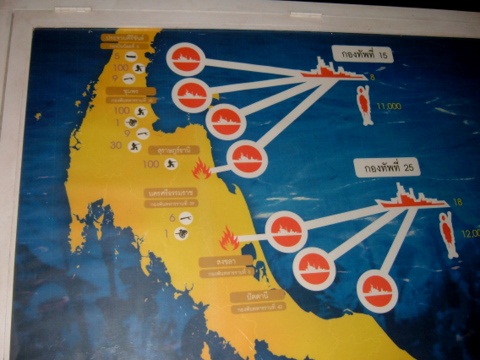
Amphibious landings – 15th & 25th Japanese Imperial Armies The 25th Japanese Imperial Army under Lieutenant General Tomoyuki Yamashita landed at Pattani and Songkla (another force landed at Kota Bahru, Malaya). This Army moved south for the invasion of Malaya. Further to the north, the 15th Japanese Imperial Army under Lieutenant General Shojiro Iida landed at Nakhon Sri Thammarat, Surat Thani, Chumphon and Prachuap Khiri Khan. This Army was earmarked for the Burma campaign. In the north-east the Japanese invaded Thailand overland through Battambang, Cambodia. Japanese planes bombed Don Muang airbase. There was initial resistance from the Thai troops deployed on the borders. When the Prime Minister Field Marshall Phibun returned to Bangkok that morning, he ordered a ceasefire on 8 December 1941 at 0730 hours. By 12 December 1941, Thailand agreed to a military alliance with Japan. On 25 January 1942, Thailand declared war on Britain and the United States. Members of the Thai government who disagreed with this decision were forced out. Pridi Banomyong the Finance Minister, was removed and made the regent. Direk Jayanama, the Foreign Minister, was sent off as ambassador to Japan. M R Seni Pramoj the Thai ambassador to the US refused to deliver the war declaration to the US. The anti-Japanese elements formed an underground resistance movement Seri Thai (Free Thai) to provide intelligence to the Allies. In a twist to the fortunes of war, the Prime Minister’s ceasefire order on the morning of 8 December 1941 didn’t reach one of the garrisons in the south until noon the following day. This was what happened. Table of contents The battle of Ao Manao Ao Manao, 5 Air Wing – 8 December 1941 0400 hours There was a waning moon over the bay four nights after the full moon as the tide was coming in two hours before dawn. It was the 20th night of the 10th lunar month in the Year of the White Metal Snake. The zodiac symbol signified strength, power and a willingness to strike to achieve one’s goals. The year lived up to this. Off the coast of Prachuap Khiri Khan, in the shadow of Khao Lom Muak, several ships were anchored as boats were lowered to the sea. Troops were climbing down cargo nets from the ships to the boats below. These troops were part of the 15th Japanese Imperial Army of Lieutenant General Shojiro Iida. The Japanese planned to land in a pincer movement. The northern pincer would land at the base of Khao Lom Muak to capture Prachaup town, cut off communications with Bangkok and protect the northern flank of the 15th Army. 
Battle plan – capture of Prachaup and Ao Manao The southern pincer would land in Ao Manao to capture the airfield between the two bays. Like Songkla to the south, the Japanese needed Ao Manao as a forward air base to support their troops. The Japanese chose their timings well. The waning moon reduced visibility. It was the last day of the spring tide and the troops will still be able to land high on the beach. The troops were landing in sheltered waters. Few fishermen would go to sea at this time of the year so the ships will not be noticed. The Japanese ships reached the Thai coast undetected. Surprise was complete, well, almost. At 0400 hours that morning, Pilot Officer Trisakdi Sudjaridtham and his colleagues were in a boat in Ao Manao trawling the bay for fish, prawns and crabs in the incoming tide. 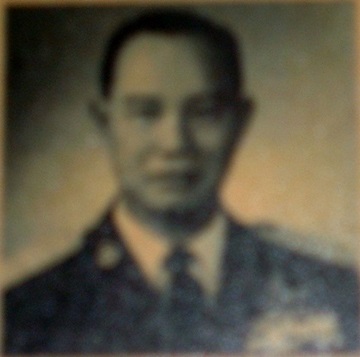
Pilot Officer Trisaksi Sudjaridtham who was 26 in 1941 As the men were hauling in their catch, Trisakdi looked out beyond the bay and noticed the dark hulks of ships. The men stopped whatever they were doing and watched in silence. The men then rushed ashore to alert the base. About 100 men were roused and armed to defend the air base. Pilot Officer Trisakdi led a group to ambush the first Japanese landing parties. The northern pincer quickly captured Prachaup town. The citizens fled in panic. All communications with Bangkok were severed. Back in 5 Air Wing, the Japanese recovered from the initial setback and renewed their attack. Five planes from the base tried to take off but all were hit by Japanese fire. At 1000 hours on 8 December, the base commander Wing Commander M L Prawat Chumsia ordered the destruction of the air traffic control tower and the HQ building. 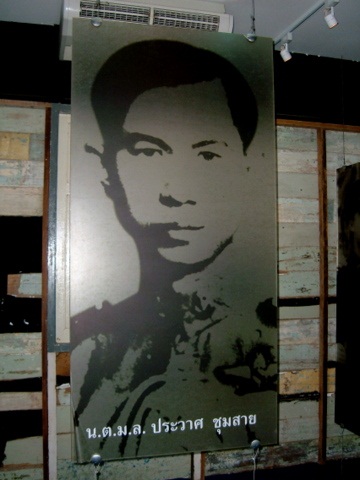
Wing Commander M L Prawat Chumsia The outnumbered defenders were forced back to the buildings at the base of Khao Lom Muak where they clung on desperately. At 1100 hours 9 December, Police Lieutenant Sa-ngob Phrommanon tried to break through the lines to deliver the ceasefire order from the Prime Minister. His vehicle was shot up and he was killed. A postman swam across Prachuap Bay, reached Khao Lom Muak and infiltrated to the defenders to deliver the ceasefire order. Early on the afternoon of 9 December, Pilot Officer Trisakdi negotiated the ceasefire with the Japanese. The agreement was signed under this tree as bayonets and samurai swords were exchanged. 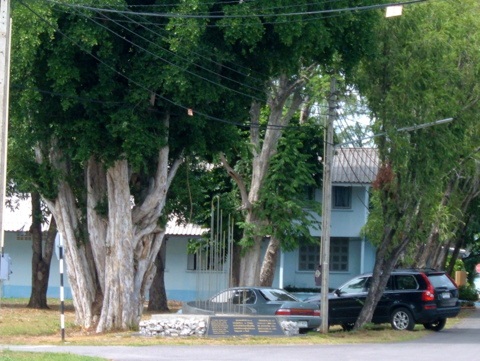
The place is marked by the vertical metal bars In the battle the Thais suffered 42 casualties, 38 Air Force officers, one police officer, one military trainee and two women. The Japanese lost about 300 men. Table of contents Why did Thailand join Japan? The Prime Minister Field Marshall Phibunsongkhram a strong and forceful leader, was an admirer of Hitler and Mussolini. The military reckoned that the days of the colonialists were over. Asia would soon be independent. 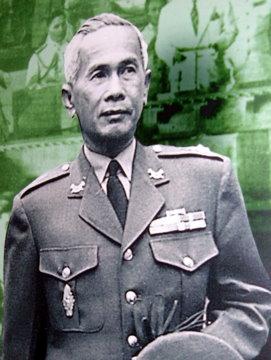
Field Marshall Plaek Phibunsongkhram – courtesy of Museum of Nonthaburi The government felt Thailand stood a better chance of retaining her independence by joining Japan, a rising Asian power. Japan would win this war and Thailand wanted to be on the side of the winner. A war against Japan would also result in untold damage to the country and immense suffering to the civilian population. There was another reason. Thailand still rankled over the loss of territories in Indo-China to France in 1893 after the French blockaded the Chao Phraya. The nationalists longed for the recovery of these territories. Events in Europe, which was on the brink of another war, would change all this. In 1936 Germany troops entered the Rhineland in violation of the Treaty of Versailles signed after World War I. This was followed by the annexation of Austria in 1938. A year later, Sudenland the German speaking territory in Czechoslovakia was turned over to Germany as an act of appeasement. The German speaking people were now under one regime. These events must have struck a familiar chord with the nationalists calling for the return of lost territories. Luang Wichit Wathakarn latched on the German model to meet Thai territorial ambitions. Wichit was the son of a Chinese trader in Uthai Thani. A brilliant student, he taught himself English and French and rose through the ranks in the Foreign Service. He expounded the concept of the Great Thai Empire beyond the present boundaries encompassing the Thai speakers in the neighbouring regions. After the fall of France in 1940, Japan invaded French Indo-China. Thailand attacked French Cambodia and Laos. There was short war with France and Japan brokered a ceasefire. Thailand got to keep Battambang and Siem Reap in Cambodia and Champasak and Luang Prabang in Laos. In May 1942 Thailand seized the Shan region in Burma completing an expedition abandoned since the mid-1800s. In 1943, Japan gave Thailand control over the northern Malay states of Kedah, Kelantan, Perlis and Trengganu which Thailand handed over to Britain in 1909. With the defeat of Japan in 1945, the victorious Allies Britain and France returned with a vengeance. Their lost territories were restored and war reparations were imposed on Thailand. The dream of a Great Thai Empire came to an end. All this does not detract from the valiant efforts of the men and women in Ao Manao. If only the ceasefire order had arrived a day earlier, perhaps they need not have lost their lives. Still they fought a courageous battle doing their duty defending their country. It wasn’t their fault if their government chose to join the side that ultimately lost. Table of contents Ao Manao today The 5 Air Wing remained in Ao Manao until 1977 when the 53 Air Wing took over the base till 2007. Since then 5 Air Wing has returned to Ao Manao where it remains till today. A beautiful beach resort Fa Chom Kluen and a golf course have been added to the base. 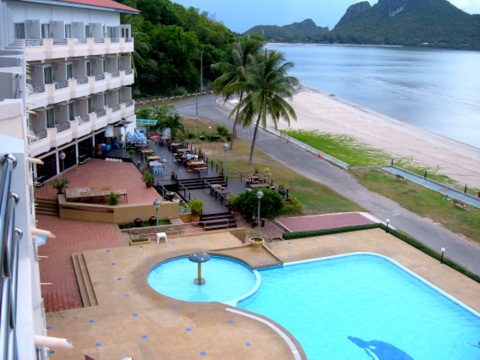
Fa Chom Kluen Fa Chom Kluen, the beach resort, is open to the public. Contact details are: Telephone: +6632 - 661 - 088/9 Fax: +6632 – 661 – 087 The mountain at the tip of the headland separating the two bays, Khao Lom Muak, is home to a rare breed of primates called Kang Waan Tin Tai (bespectacled langurs from the south). 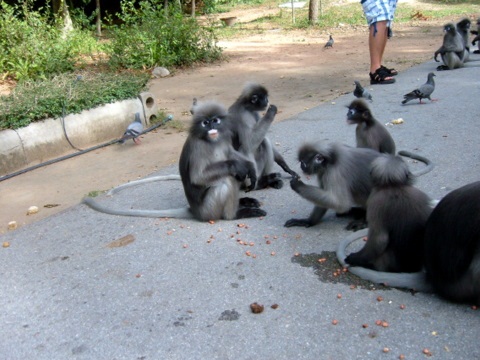
Our bespectacled friends These primates are dusky langurs of the Presbytis species, Presbytis Obscura Reid. 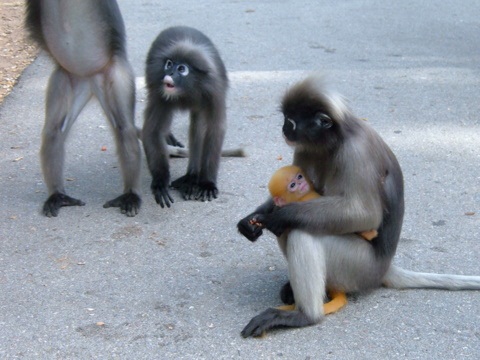
Mother and child The bright orange of the new born will change to grey when they are three months old. These langurs live in forests in southern Thailand and are shy by nature. 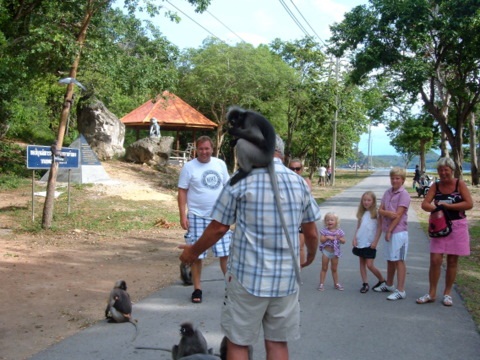
However, this lot is quite used to humans The dusky langurs are going extinct and are now protected under the Thai Wildlife Protection Act 1992. Within the base there is a Historical Park with several monuments for those who died in the battle in 1941. 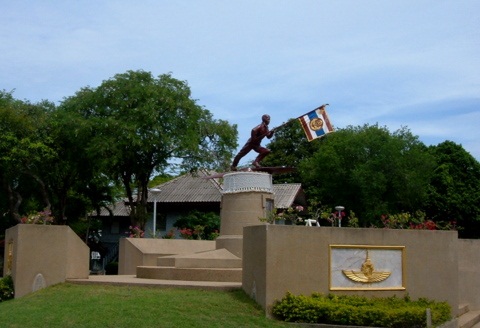
Monument for the fallen The parade ground between these two monuments is where the annual commemorative parade is held on 8 December to honour those who died during that battle. 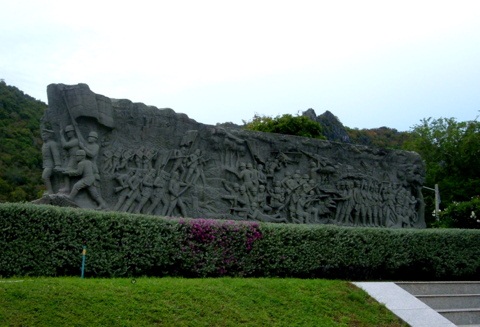
The stone slab for this sculpture is from Korat and the work took a year to complete A sight and sound presentation of the battle of Ao Manao can be viewed in this building. 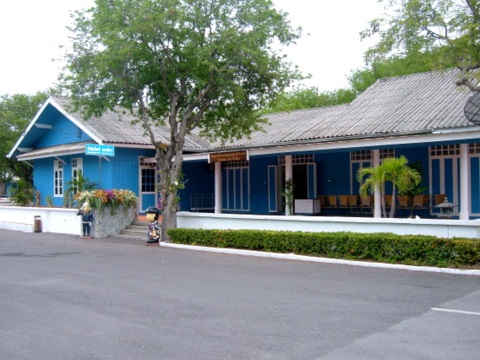
Sight & sound presentation This old building was built in 1922 and was originally the living quarters for commissioned officers and their families. The long building can accommodate 10 families. 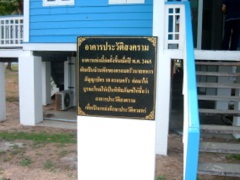
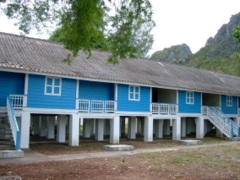
Entrance to the museum (left) Part of the long barracks (right) It was later converted to a War Museum tracing the major events during World War II leading up to the Japanese invasion. I particularly liked the section devoted to preserving barrack life in those days. 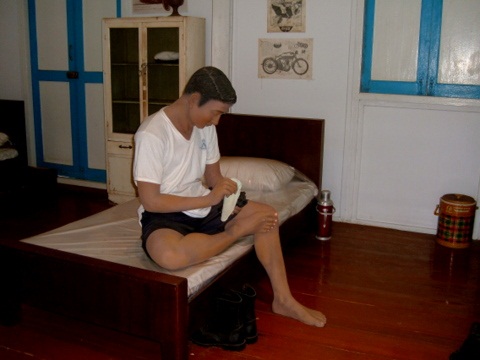
Barrack life These exhibits reflect the simple and spartan life back then. 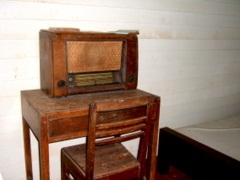
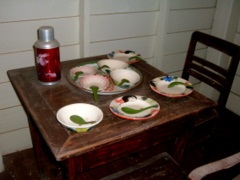
An old radio (left) set for a simple meal (right) The dawn over Ao Manao is sheer beauty with birds chirping to the splash of waves on the beach as trees bow to the gentle breeze blowing across the bay. 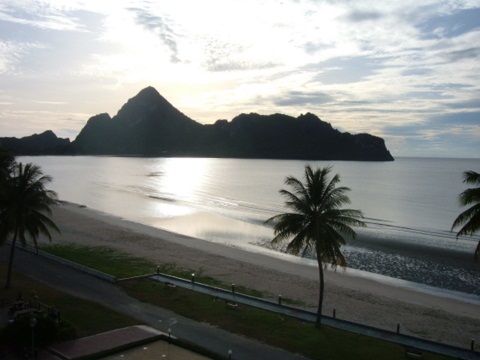
Dawn at Ao Manao In the distance Khao Lom Muak stands steadfast like a silent sentinel over the peaceful Bay of Lemons. 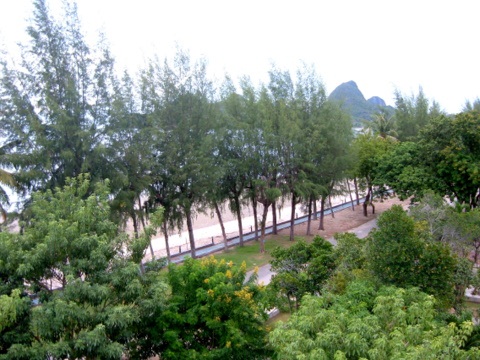
Bowing to the gentle breeze It’s hard to imagine that a battle took place here at dawn 69 years ago, a battle that was raging by this time in the morning. Table of contents Epilogue Pilot Officer Trisakdi Sudjaridtham, the sole survivor of the battle at Ao Manao, is 95 and retired in Prae province in northern Thailand about 800 km from Ao Manao. Every year on 8 December he makes it a point to attend the ceremony at Ao Manao to commemorate his comrades who died in that battle. This December 2010, he intends to be there. 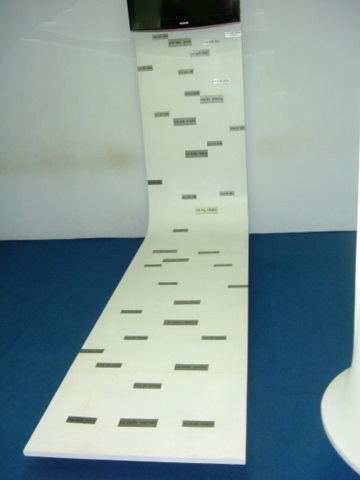
The roll of honour Nothing is more binding than the friendship of companions-in-arms. George Stillman Hillard Fading light dims the sight And a star gems the sky Gleaming bright from afar Drawing nigh falls the night Extracts from the unofficial lyrics to Taps the bugle call played at US military funerals and remembrance ceremonies Table of contents Acknowledgements Thank you Pa (Aunt) Pui for taking us around the base and the Historical Park. My thanks to the staff of the War Museum for the conducted tour and for permission to take photos of the Ao Manao Historical Park and War Museum. Most of all thank you Pa Pui for this sumptuous seafood dinner. 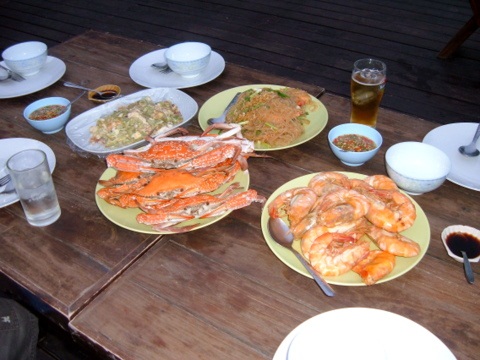
Fresh from the bay My thanks also to Nid, Pui and Boon Ping, without them this trip would not be possible. Incidentally, Nid and Pui run a local radio station called Fulfill Radio in Chiang Mai, FM 102.5. 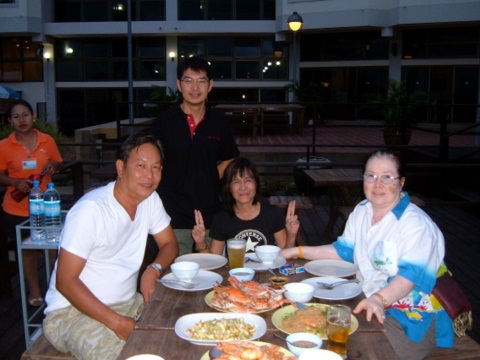
(right – left) Pa Pui, Nid, Boon Ping (standing), Pui Table of contents 
Next month Rayong – jewel of the east If you enjoyed reading this e-zine, please forward it to a friend. If you received this from a friend and found it interesting, please subscribe at Bangkok Travelbug. What you think of the Bangkok Travelbug? We love to hear from you What other subscribers have said Till next month then. Eric Lim Stay updated with what’s new at Tour Bangkok Legacies. Copy the link below and paste it into your Google Reader, NetNewsWire or your favorite feed reader. https://www.tour-bangkok-legacies.com/tour-Bangkok-legacies.xml If you use My Yahoo! or My MSN, head over to my home page and click on the button for your favourite Web-based feed reader. Visit our home page at Tour Bangkok Legacies. Copyright@2008-2009 Tour Bangkok Legacies All rights reserved |
| Back to Back Issues Page |